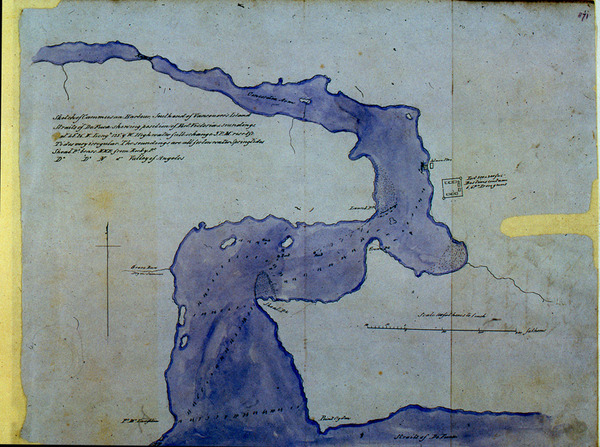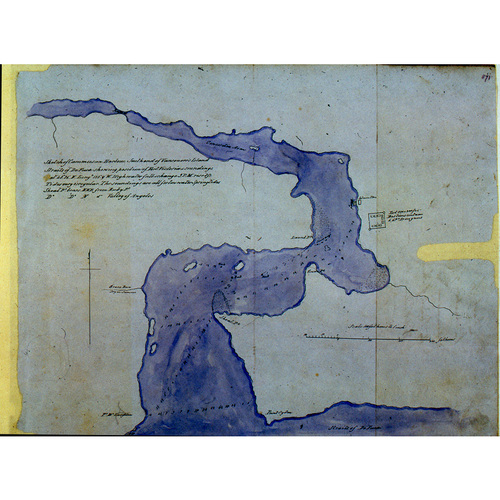
Source: Courtesy of Wikimedia Commons
VAVASOUR, MERVIN, soldier; b. probably at Fort George (Niagara-on-the-Lake), Upper Canada, in 1821, son of Captain Henry William Vavasour of the Royal Engineers and Louisa Dunbar, daughter of Sir George Dunbar; m. 23 Oct. 1860 Frances Elizabeth Hartwell Dickson in Manchester, England, and they had at least two daughters; after her death in 1863 m. Georgiana Oakes on 12 Jan. 1866; d. 27 March 1866 at Niagara Cottage, Henley on Thames, England.
Mervin Vavasour entered the Royal Military Academy, Woolwich, England, as a gentleman cadet in February 1837, and was commissioned into the Royal Engineers as a 2nd lieutenant on 19 March 1839. From 1839 to 1841 he attended the Royal Engineer Establishment (School of Military Engineering) at Chatham for instruction in field engineering and related subjects. He was posted to Canada and arrived at Montreal on 18 Sept. 1841.
Vavasour was first stationed at Kingston, and in 1842 was promoted lieutenant. From August 1843 to 13 Oct. 1846 he worked on the Ottawa and Rideau canals, with the exception of the period from 5 May 1845 to 20 July 1846 when he was on special service, participating in a military reconnaissance mission to the Oregon Territory with Henry James Warre.
The political status of the territory west of the Rocky Mountains had been left unresolved since 1827 when Great Britain and the United States agreed to occupy it jointly. By 1845 British-American relations were strained. On 29 March Sir George Simpson* prepared a memorandum recommending the strengthening of British military and naval forces in Red River and Oregon and on the Pacific coast to provide more protection to British and Hudson’s Bay Company interests. Soon after, Sir Richard Jackson*, commander of the forces in Canada, on instruction from Lord Aberdeen, selected Warre and Vavasour to go to the Oregon Territory disguised as travellers to examine how British territory on the Pacific coast might be defended in case of war with the United States. They arrived at Fort Vancouver (Vancouver, Wash.) on 25 Aug. 1845 and proceeded to reconnoitre much of the country from the Willamette valley to Fort Victoria. In September 1845 they conferred with Lieutenant William Peel, son of Sir Robert Peel, and Captain John Gordon of hms America. Gordon’s ship had come to give support to the HBC and he had sent Peel to report on American settlement. Peel then went to London with his own, Gordon’s, and John McLoughlin*’s reports on the situation in Oregon in February 1846. The arguments Peel presented to the British authorities for the retention of Vancouver Island if the 49th parallel were adopted as the boundary came at a critical time in the negotiations leading up to the Oregon Treaty signed by Great Britain and the United States on 15 June 1846. It is probable that the reports Peel transmitted strengthened the British approach towards the treaty, which did in effect divide British and American territory at the 49th parallel and reserve Vancouver Island as British territory.
Although neither Peel nor Gordon acknowledged the conversations they had with Warre and Vavasour, the views expressed by Warre and Vavasour on Oregon in their reports on the west coast (which arrived in London in July 1846, after the signing of the treaty) were similar. Warre and Vavasour were not encouraging about the defence of the area. They pointed out the deficiencies in the British military position in Oregon, stressed the impracticality of using overland routes for troops, who moreover would be dependent on inadequately provisioned posts, and commented on the shortcoming of Victoria as a port. They also wrote that HBC policies had encouraged American immigration to Oregon, a criticism which McLoughlin interpreted as “character assasinated in the dark.”
Warre and Vavasour had left Oregon for Montreal on 25 March 1846. Vavasour embarked for England in October. He joined the Ordnance Survey of Ireland on 1 Jan. 1847 and served briefly on the Trigonometrical Survey of Great Britain in 1848. He then returned to the Survey of Ireland and was promoted 2nd captain in 1849. He went on sick leave in 1850, but recovered to serve in the West Indies in 1851–52. In 1853 he went on half pay, and died in 1866.
Institution of Royal Engineers (Chatham, Eng.), Conolly papers, index and notitia historica, 10, p.2. PAC, MG 24, F71. PRO, FO 5/440; 5/442; 5/457 (copies at PABC); WO 54/250–59. Royal Military Academy (Woolwich, Eng.), Register of cadets, 1837–39. P. J. De Smet, Oregon missions and travels over the Rocky Mountains, in 1845–46 (New York, 1847). “Documents relative to Warre and Vavasour’s military reconnoissance in Oregon, 1845–6,” ed. Joseph Schafer, Oreg. Hist. Soc., Quarterly (Salem and Portland), X (1909), 1–99. HBRS, VII (Rich). [John McLoughlin], “McLoughlin’s answer to Warre report,” ed. H. A. Leader, Oregon Hist. Quarterly (Salem), XXXIII (1932), 214–29. [William Peel], “Report of Lieutenant Peel on Oregon in 1845–46,” ed. L. M. Scott, Oreg. Hist. Soc., Quarterly (Eugene), XXIX (1928), 51–76. “Secret mission of Warre and Vavasour,” Washington Hist. Quarterly (Seattle), III (1908–12), 131–53. H. [J.] Warre, Sketches in North America and the Oregon Territory ([London, 1848?]; repr. Barre, Mass., 1970). Roll of officers of the Corps of Royal Engineers from 1660 to 1898, complied from the ms. rolls of the late Captain T. W. J. Conolly, R.E. . . . , ed. R. F. Edwards (Chatham, Eng., 1898). B. M. Gough, The Royal Navy and the northwest coast of North America, 1810–1914: a study of British maritime ascendancy (Vancouver, 1971), 68–75; “H.M.S. America on the north Pacific coast,” Oregon Hist. Quarterly (Portland), LXX (1969), 293–311. F. M. Woodward, “The influence of the Royal Engineers on the development of British Columbia,” BC Studies, 24 (winter 1974–75), 3–51.
Cite This Article
Frances Woodward, “VAVASOUR, MERVIN,” in Dictionary of Canadian Biography, vol. 9, University of Toronto/Université Laval, 2003–, accessed December 30, 2025, https://www.biographi.ca/en/bio/vavasour_mervin_9E.html.
The citation above shows the format for footnotes and endnotes according to the Chicago manual of style (16th edition). Information to be used in other citation formats:
| Permalink: | https://www.biographi.ca/en/bio/vavasour_mervin_9E.html |
| Author of Article: | Frances Woodward |
| Title of Article: | VAVASOUR, MERVIN |
| Publication Name: | Dictionary of Canadian Biography, vol. 9 |
| Publisher: | University of Toronto/Université Laval |
| Year of publication: | 1976 |
| Year of revision: | 1976 |
| Access Date: | December 30, 2025 |



